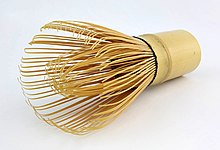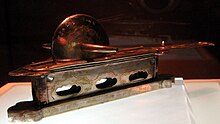Dian cha
This article needs additional citations for verification. (September 2024) |

Dian cha (Chinese: 點茶), is a method of preparing and drinking tea in Sinosphere includes China, Japan, and Vietnam. It later evolved into the Japanese tea ceremony using matcha.
This art originated in China. It was popular in China during the Song Dynasty and was one of the "Four Arts" of the Song Dynasty.[1] In Vietnam, dian cha (Tiếng Việt: điểm trà) was probably popular during the Trần and Lê dynasties. However, by the end of Revival Lê dynasty, this method in Vietnam had been lost.[2] In China, dian cha also gradually declined during the Ming Dynasty. Today, the art of dian cha in which using matcha is still popular and preserved in Japan. This is the main art used in Japanese tea ceremony.
Method
[edit]
The original matcha in Song era was often made in the form of tea bricks or cakes. The tea cakes were made of matcha pressed into bricks. In the Song era, serving the tea from tea bricks or cakes required the following steps:
- Water was boiled in a porcelain ewer (pitcher).
- Toasting: Tea bricks are usually first toasted over a fire to destroy any mould or insects that may have burrowed into the bricks during storage.
- Grinding: The tea brick was crushed and ground with a tea grind tools includes mill or nian (Chinese: 碾) to a fine powder which was placed in a bowl called chawan.
- Whisking: The powdered tea was mixed with hot water and beaten with a bamboo whisk called Chaxian (茶筅) or in Japan called Chasen before serving.
Tea utensils
[edit]
Two important tools in dian cha are:

The full tools set for preparing tea according to Lu Yu (733 - 804) the author of "The Classic of Tea" in Tang dynasty includes 24 tools.
Dian cha in the countries
[edit]China
[edit]
Dian cha was one of the two popular methods of making tea during the Song Dynasty. Drinking tea was also one of the important elegant pleasures, forming a typical lifestyle for literati and scholars.
Song dynasty matcha was made into tea cakes. Before drinking, it would need to be ground and sifted into a fine powder. It was also necessary to warm the cup before brewing the tea, otherwise the matcha would not float easily.[3]
The froth, colour and patterns formed by the whisked tea were aesthetically important for the elites and whisking was considered a gentleman's skill. The whisked frothy teas led to the rise in popularity of dark patterned bowls in which the texture of the thick whisked tea could be more easily judged, as the white froth contrasted more easily with dark bowls.[4]
The best of these bowls were the Jian ware made in the Jianzhou kilns, glazed in patterns with names like oil spot, partridge feather, hare's fur, and tortoise shell.[4] These styles are still highly valued today. The patterned holding bowl and tea mixture were often lauded in the period's poetry, with phrases such as "partridge in swirling clouds" or "snow on Hare's fur." A popular pastime was to create use various implements like spoons to create art on the tea froth which would depict things like birds, fish, flowers and plants.[4]
Japan
[edit]Japanese tea ceremony uses the Dian cha method with matcha as the ingredient. This method was introduced from China during the Tang and Song dynasties. Today, tea pointing is still preserved and developed in Japan, making matcha famous worldwide.
Vietnam
[edit]In Vietnam, dian cha method was popular during the Trần and Initial Lê dynasties, alongside the practice of boiled tea method. The tea-lighting method was recorded in "Quần thư tham khảo" and "Bị khảo lục" (備考錄) written by Phạm Đình Hổ (范廷琥, 1768 - 1839). However, by the end of Revival Lê dynasty, this method in Vietnam had been lost.[2]
Many chawan and tea-setting utensils were found at Imperial Citadel of Thăng Long with designs similar to Song Dynasty tea utensils of China and Japan.[2]
References
[edit]- ^ "茶" (in Chinese). Archived from the original on 2005-04-20. Retrieved 2011-03-02.
- ^ a b c Trần, Quang Đức (2021). Chuyện trà. Nhà xuất bản Thế Giới. pp. 185–204. ISBN 978-604-77-9986-2.
- ^ "Record of Tea"《茶錄》(凡欲點茶,先須劦盞令熱,冷則茶不浮"。)
- ^ a b c Mair, Victor H. The True History of Tea, ch. 5, Thames & Hudson (2012).
